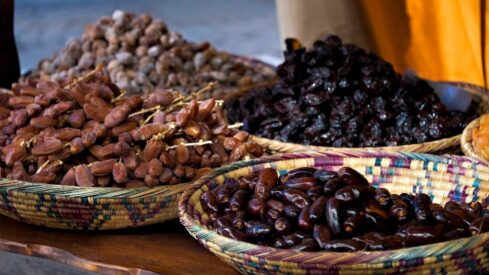It is recommended to break our fast on dates”, as Prophet Mohammad (peace and blessings be upon him) used to do:
“Break your fast by eating dates as it is purifying.” (Narrated by Ahmad)
“إذا أفطر أحدكم فليفطر على تمر، فإنه بركة، فإن لم يجد تمرا فليفطر على الماء، فإنه طهور” (رواه أحمد في مسنده والأربعة [أبو داود، الترمذي، النسائي، ابن ماجه].
He said in another Hadith:
“في عجوة العالية، أول البكرة على ريق النفس، شفاء من كل سحر أو سم”. (رواه أحمد)
“The date that is from high [branches] is a cure”. (Narrated by Muslim and Ahmad.)
Let’s look at the characteristics and benefits of dates.
Date palm, Phoenix dactylifera L., is one of the oldest fruit trees in the world, known as the tree of life. The number of date palms is about 105 million worldwide covering an area of 800,000 ha, of which 62 million palms are found in the Arab world. The place of origin of the date palm is uncertain. Some claim that the date palm first originated in Babel, Iraq, while others believe that it originated in Dareen or Hoff, Saudi Arabia or Harqan, an island on the Arabian Gulf in Bahrain.
The date palm is a perennial plant and is characterized by its slow growth. There are male and female trees. The females normally begin to bear dates within an average of five years from the time of planting. The date palm can live for about 150 years.
Date palm is distributed throughout the Middle East, North Africa and South Sahel, areas of East and South Africa, Central and South America and even in Southern Europe (Spain and Italy).
On a commercial scale, the Middle East and North Africa are the major date palm producing areas in the world.
Date palm trees are essential integral components of farming systems in arid and semi-arid regions, and can be produced equally well in small farm units or as large scale commercial plantations. The great advantage of the tree is its resilience, its need for only limited water input, its long-term productivity and its multiple purpose qualities.
The fruit of the date palm is delicious and sweet. In addition to producing a valuable dessert fruit, valuable by-products such as building materials and versatile starting materials for handicrafts can be derived from its leaves and trunks. The palm tree is one of the basic elements of the flora in the region and supplies 1.4 million tons of DPLM (date palm leaves) annually.
The date palm also makes a significant contribution towards the creation of equable microclimates within oasis ecosystems, thus enabling agricultural development to be sustained in many drought- and saline-affected areas.
Nutritional value of dates:
The nutritional value of the relatively easy-to-store date fruit is high in sugar – comprising up to 70% of the fruit. (In most varieties the sugar component consists of glucose and fructose.) Dates are also good sources of iron, potassium (150mg in 100g), magnesium (important for use of voluntary muscles), sulphur, copper, calcium and phosphorus (important in building muscles and neuro-tissues), along with various vitamins, including thiamine, riboflavin, biotin, folic and ascorbic acid. Water is 13.8% and proteins are about 3%.
One kilogram of dates gives the body 3470 calories shortly after eating it. This energy will satisfy your appetite, which is very important especially while breaking your fasting.
This rich fruit plays an important role in the nutrition of human populations in the above regions. Its use also as a supplement fodder for livestock gives the tree more value. The secondary products generated from fruits are syrups, jams, ice creams, baby foods, alcoholic beverages and soft drinks. Small and intermediate-scale industries can therefore be supported over long term periods in both urban and rural situations. This is reflected in its widely acknowledged sustainability value in social, economic and ecological terms.
An ongoing study at Ain Shams University in Cairo has been exploring the possibilities of manufacturing wood from the midrib sections of date palm leaves, which are abundant in Egypt and the Arab world
Palm trees (Nakhl) in Quran:
Nakhl is mentioned frequently in the Quran, especially when showing the miracles of Allah’s creation and the pleasures, which were created for man.
With it He produces for you corn, olives, date palms, grapes and every kind of fruit; verily this is a sign for those who give thought. (Surat an-Nahl: verse 11)
Also, in the story of Maryam, pains drove the blessed mother of Jesus (peace be upon them) to the trunk of a palm tree. She was ordered to eat from the fresh ripe dates.
And shake towards thyself the trunk of the palm tree, it will let fall fresh ripe dates upon thee…So eat and drink and cool (thine) eye. (Surat Maryam: verses 25, 26)
According to scientific studies, the ripe date contains a substance that urges uterine spasms and increases contractions especially in the time of delivery. This substance resembles ‘oxytocin’ that is secreted by the interior lobe of pituitary gland, which encourages contractions of the uterus.
The best kind of palm tree is the kind that is grown without any artificial chemicals, sprays, fumigants, or sulphur and without steaming, hydrating or preservatives.
California is one of the places where they are grown that way: 68 feet below sea level in the 110-degree heat of the California desert.
Don’t miss a breakfast with dates when sunset appears.
By Karima Burns


















